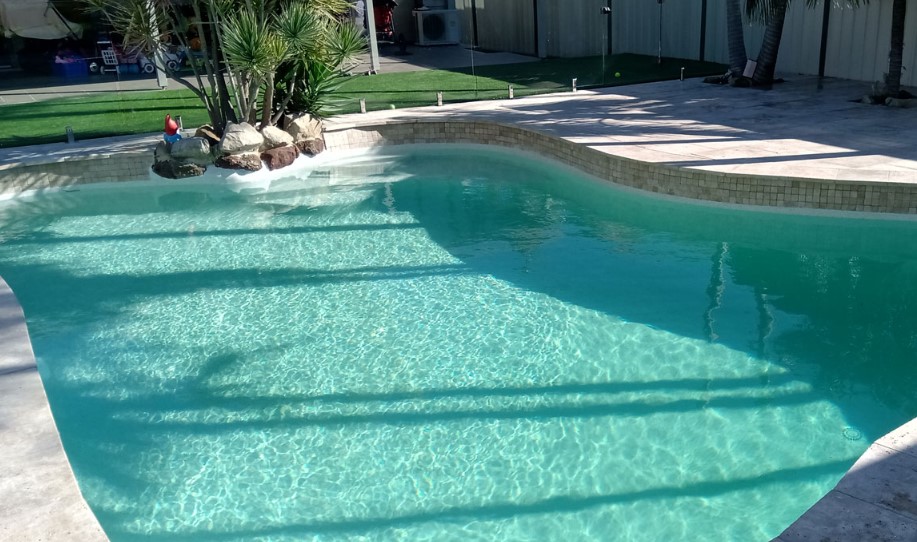Commercial pool renovation and restoration is a process aimed at renewing the appearance, functionality, and safety of a commercial swimming pool. Over time, pool surfaces can deteriorate due to wear and tear, weather, and chemical exposure. Renovating or resurfacing the pool can extend its lifespan and provide an improved experience for patrons. Here are the key steps and considerations for commercial pool resurfacing and restoration:
-
Assessment and Planning:
- Begin by conducting a thorough assessment of the pool’s current condition. Identify issues such as cracks, chips, delamination, staining, or surface roughness.
- Collaborate with pool renovation professionals to develop a comprehensive plan that addresses structural repairs, surface resurfacing, and any desired upgrades or enhancements.
-
Budgeting and Financing:
- Establish a clear and realistic budget for the resurfacing and restoration project. Consider all associated costs, including materials, labor, permits, equipment, and any contingencies for unexpected issues.
- Explore financing options if necessary to ensure you have the necessary funds to complete the project.
-
Regulatory Compliance and Permits:
- Ensure that the renovation project complies with local, state, and federal regulations, as well as building codes and safety standards.
- Obtain the required permits and approvals from relevant authorities before commencing work to avoid potential legal issues.
-
Safety Upgrades:
- Prioritize safety enhancements during the restoration process. Address any safety concerns, such as damaged or missing safety features, and ensure compliance with current safety standards.
- Consider installing anti-entrapment drain covers, lifeguard stations, first aid stations, and emergency phone systems as needed.
-
Structural Repairs:
- Address structural issues, including cracks, leaks, or damage to the pool’s shell or foundation. Properly repair and reinforce these areas to ensure structural integrity.
- Waterproofing and surface preparation are essential to prevent future water leakage.
-
Resurfacing Options:
- Choose a suitable resurfacing material based on your budget and aesthetic preferences. Common options include plaster, aggregate (pebble or quartz), tiles, or other specialty finishes.
- Consider decorative finishes and patterns to enhance the pool’s visual appeal.
-
Accessibility and Inclusivity:
- Ensure that the restored pool area is accessible to individuals with disabilities by incorporating features like ADA-compliant lifts, ramps, handrails, and clear pathways.
- Implement universal design principles to create an inclusive and welcoming environment.
-
Equipment and Systems:
- Evaluate the condition of pool equipment, such as pumps, filters, heaters, and lighting systems. Upgrade or replace outdated equipment for energy efficiency and better performance.
- Consider automation systems for improved control and maintenance efficiency.
-
Energy Efficiency and Sustainability:
- Incorporate energy-efficient technologies, such as variable-speed pool pumps, LED lighting, and solar heating, to reduce long-term operating costs and environmental impact.
- Implement water-saving strategies, such as pool covers and efficient filtration systems.
-
Project Timeline and Communication:
- Develop a realistic project timeline, accounting for potential weather-related delays, permit processing times, and contractor availability.
- Maintain open and transparent communication with stakeholders, including facility managers, staff, and pool users.
-
Quality Assurance and Inspections:
- Work with experienced professionals and reputable contractors with a proven track record in commercial pool restoration.
- Conduct regular inspections to ensure that all work is completed to high standards and that safety features and equipment are functioning correctly.
-
Maintenance and Training:
- Develop a comprehensive maintenance plan to preserve the restored pool’s condition and functionality.
- Train pool staff on proper maintenance procedures, chemical balance, and equipment operation.
By following these steps and considering the unique needs of your commercial pool, you can successfully complete the resurfacing and restoration project, ensuring that the pool remains safe, attractive, and functional for years to come.


